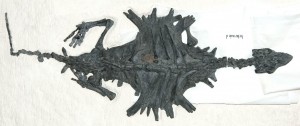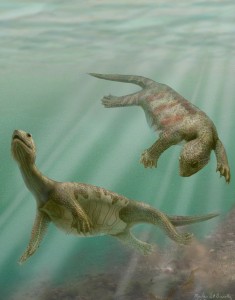 A 220 million year-old fossil is stirring debate over the evolutionary origin of turtles.
A 220 million year-old fossil is stirring debate over the evolutionary origin of turtles.
Turtles have a completely unique body design that has remained almost unchanged for millions of years. Paleontologists have long been interested in how the turtle’s shell evolved, but there were few clues in the fossil record.
Up to this point, the oldest turtle fossil on record was Proganochelys, a heavily-armored primitive turtle from the Late Triassic found in Germany. But since this turtle already possessed a fully-formed shell, the origin of its unusual protective covering has remained a mystery. What was missing was some kind of intermediate step between the turtle’s shell-less reptile ancestors and the creatures as we know them today.
Enter the new primitive turtle described in this week’s edition of Nature. Paleontologist Chun Li from the Chinese Academy of Sciences in Beijing and Canadian colleagues have discovered the remains of a 40 centimetre-long marine reptile that they have named Odontochelys, or ‘toothed tortoise’. Unlike modern turtles, the animal lacks a bony upper shell, or carapace. However, the ribs on its back show evidence of expansion, and its lower shell, or plastron, is completely developed and in place.

According to the paper’s authors, this fossil indicates that turtles evolved their lower shells before their upper shells — presumably, in a marine environment, to protect their bellies against attacks from creatures swimming below them in the water. It also gives evidence to support the theory that the upper shell grew from a broadening of the ribs and backbone, not from the growth of bony skin plates which is seen in some dinosaurs and crocodiles.
This claim lines up neatly with the way the shell develops in a modern turtle embryo. If accepted, it will overturn the current thinking that turtles descended from armor plated dinosaur-like reptiles on land.
However, another group of scientists writing in the same journal provides a different take on the matter: maybe the primitive turtle did have an upper shell, but it wasn’t bony enough to be preserved in fossils.
These scientists point to the softening of shells in some modern aquatic turtles like sea turtles and snapping turtles as examples. They hypothesise that the turtle developed its full shell on land, later losing part of it when relocating to the water. For them, Odontochelys represents a special case, not the ‘missing link’ in turtle evolution.
Either way, vertebrate paleontologists are excited to see the frontiers of their field pushed further back in time by several million years, and are eager to start debating the implications of this apparent turtle on a half shell, the oldest turtle yet known.
hmmmm is that true??? i can’t believe it!!